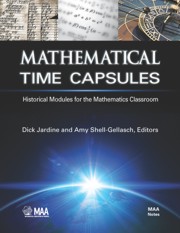Book contents
- Frontmatter
- Preface
- Contents
- 1 The Sources of Algebra
- 2 How to Measure the Earth
- 3 Numerical solution of equations
- 4 Completing the Square through the Millennia
- 5 Adapting the Medieval “Rule of Double False Position” to the Modern Classroom
- 6 Complex Numbers, Cubic Equations, and Sixteenth-Century Italy
- 7 Shearing with Euclid
- 8 The Mathematics of Measuring Time
- 9 Clear Sailing with Trigonometry
- 10 Copernican Trigonometry
- 11 Cusps: Horns and Beaks
- 12 The Latitude of Forms, Area, and Velocity
- 13 Descartes' Approach to Tangents
- 14 Integration à la Fermat
- 15 Sharing the Fun: Student Presentations
- 16 Digging up History on the Internet: Discovery Worksheets
- 17 Newton vs. Leibniz in One Hour!
- 18 Connections between Newton, Leibniz, and Calculus I
- 19 A Different Sort of Calculus Debate
- 20 A ‘Symbolic’ History of the Derivative
- 21 Leibniz's Calculus (Real Retro Calc.)
- 22 An “Impossible” Problem, Courtesy of Leonhard Euler
- 23 Multiple Representations of Functions in the History of Mathematics
- 24 The Unity of all Science: Karl Pearson, the Mean and the Standard Deviation
- 25 Finding the Greatest Common Divisor
- 26 Two-Way Numbers and an Alternate Technique for Multiplying Two Numbers
- 27 The Origins of Integrating Factors
- 28 Euler's Method in Euler's Words
- 29 Newton's Differential Equation ẏ/ẋ = 1 − 3x + y + xx + xy
- 30 Roots, Rocks, and Newton-Raphson Algorithms for Approximating √2 3000 Years Apart
- 31 Plimpton 322: The Pythagorean Theorem, More than a Thousand Years before Pythagoras
- 32 Thomas Harriot's Pythagorean Triples: Could He List Them All?
- 33 Amo, Amas, Amat! What's the sum of that?
- 34 The Harmonic Series: A Primer
- 35 Learning to Move with Dedekind
- About the Editors
30 - Roots, Rocks, and Newton-Raphson Algorithms for Approximating √2 3000 Years Apart
- Frontmatter
- Preface
- Contents
- 1 The Sources of Algebra
- 2 How to Measure the Earth
- 3 Numerical solution of equations
- 4 Completing the Square through the Millennia
- 5 Adapting the Medieval “Rule of Double False Position” to the Modern Classroom
- 6 Complex Numbers, Cubic Equations, and Sixteenth-Century Italy
- 7 Shearing with Euclid
- 8 The Mathematics of Measuring Time
- 9 Clear Sailing with Trigonometry
- 10 Copernican Trigonometry
- 11 Cusps: Horns and Beaks
- 12 The Latitude of Forms, Area, and Velocity
- 13 Descartes' Approach to Tangents
- 14 Integration à la Fermat
- 15 Sharing the Fun: Student Presentations
- 16 Digging up History on the Internet: Discovery Worksheets
- 17 Newton vs. Leibniz in One Hour!
- 18 Connections between Newton, Leibniz, and Calculus I
- 19 A Different Sort of Calculus Debate
- 20 A ‘Symbolic’ History of the Derivative
- 21 Leibniz's Calculus (Real Retro Calc.)
- 22 An “Impossible” Problem, Courtesy of Leonhard Euler
- 23 Multiple Representations of Functions in the History of Mathematics
- 24 The Unity of all Science: Karl Pearson, the Mean and the Standard Deviation
- 25 Finding the Greatest Common Divisor
- 26 Two-Way Numbers and an Alternate Technique for Multiplying Two Numbers
- 27 The Origins of Integrating Factors
- 28 Euler's Method in Euler's Words
- 29 Newton's Differential Equation ẏ/ẋ = 1 − 3x + y + xx + xy
- 30 Roots, Rocks, and Newton-Raphson Algorithms for Approximating √2 3000 Years Apart
- 31 Plimpton 322: The Pythagorean Theorem, More than a Thousand Years before Pythagoras
- 32 Thomas Harriot's Pythagorean Triples: Could He List Them All?
- 33 Amo, Amas, Amat! What's the sum of that?
- 34 The Harmonic Series: A Primer
- 35 Learning to Move with Dedekind
- About the Editors
Summary
Introduction
One of the classic examples to demonstrate the so-called Newton-Raphson method in undergraduate calculus is to apply it to the second-degree polynomial equation x2 – 2 = 0 to find an approximation to the square-root of two. After several iterations the solution converges quite quickly. Indeed, √2 has fascinated mathematicians since ancient times, and one of its earliest expressions is found on a cuneiform tablet written, it is supposed, some time in the first third of the second millennium B.C.E by a trainee scribe in southern Mesopotamia. While keeping this mathematical artifact firmly in its original archaeological and mathematical context, we look at the similarities and differences it shares with modern mathematical techniques, 3000 years distant.
Observing that mathematical knowledge is, to a certain extent, culturally dependent can be revelatory to students. Modern mathematical pedagogy is generally based around a cumulative approach which allows little room for lateral breadth, as it focuses on the acquisition of skills, often with scant regard for the actual manifestation or circumstances of mathematical knowledge itself. Students may have never been exposed to other contexts in which mathematics flourished, nor encountered different mathematical traditions thus far in their studies, much less non-western ones. Yet, such exposure can give them a vital and nuanced perspective on their own mathematical circumstances. Though many a mathematical problem posed may be universal, the ways in which various mathematically literate cultures attacked them and solved them are diverse, depending on many other factors related to the broader intellectual environment. This is an important observation to bequeath to future mathematically-literate generations. However, at the same time, the universality of mathematics should not be forgotten.
- Type
- Chapter
- Information
- Mathematical Time CapsulesHistorical Modules for the Mathematics Classroom, pp. 229 - 240Publisher: Mathematical Association of AmericaPrint publication year: 2011



